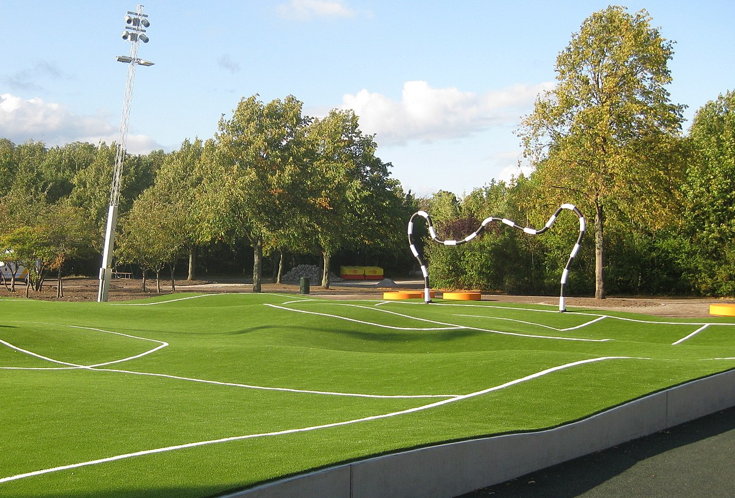Image source: Jorchr, CC BY-SA 3.0, via Wikimedia Commons
Football is a sport that encompasses much more than just the matches themselves. From the humble whistle to the iconic corner flag, there are countless aspects of the game that we often take for granted. Today, let’s delve into the history of football goals and goalposts, two crucial components that have been at the heart of the beautiful game for centuries.
The First Use of a ‘Goal’
If we trace back the origins of football, we can find references to a prototype of goals dating back to ancient times. In China, during the reign of the Chinese Emperor Ch’eng Ti in 32 B.C., a form of the sport had bamboo sticks with a silk net stretched between them as the early version of a goal.
Bạn đang xem: The Evolution of Football Goals: From Bamboo Sticks to State-of-the-Art Steel
In England, the concept of a goal began to take shape in 1681 when the King’s servants played against the Duke of Albermale’s team, using the doorways of two forts as their targets. However, it wasn’t until the middle of the 19th century that modern football, with its familiar rules and regulations, emerged. During this period, the definition of a goal went through several changes.
The Football Association’s Rules
The year 1863 marked a turning point for football, as it saw the establishment of the Football Association and the first official set of rules. While many aspects of the game have evolved over time, the FA’s original ruling on the distance between goalposts has remained intact ever since. According to the 1863 rules, the goalposts should be eight yards apart. Surprisingly, these rules did not mention the existence of a crossbar at that time.
Xem thêm : The Best Soccer Countries in the World
In the early days of football, clubs had to improvise with string or tape to create a crossbar. However, this led to disputes over whether a goal was valid if the ball went significantly higher than the posts. To resolve this, the Football Association made it mandatory to use tape between the goalposts starting in 1866. This change was met with acceptance by clubs, including Sheffield Football Club and Queens Park, which both claimed to be the first to install a crossbar. The crossbar eventually became a standard feature in goals when the rules were amended again in 1882.
Nets As ‘Huge Pockets’
Similarly to the crossbar, the use of netting to prevent debates over goal-scoring was not part of the original 1863 FA Rules of the Game. As football gained popularity, disputes often arose regarding whether a ball had actually crossed the goal line.
In 1891, John Brodie, an engineer from Liverpool, introduced a game-changing solution. Inspired by the large pockets on his trousers, he devised nets that would catch and cradle the ball if it was legitimately scored. After successful trials in Nottingham, the Football Association accepted Brodie’s invention, making it an official part of the game in 1892.
Even with the introduction of nets, controversies persisted. In 1909, West Brom was denied a goal when the ball hit the net but immediately bounced back out, resulting in their failure to secure promotion. Similar incidents occurred throughout the history of football, with missed goals causing significant consequences.
The Shape of the Posts
Xem thêm : How to Become a Sports Analyst
Until 1987, football goalposts were actually square. It wasn’t until the European Cup final between Bayern Munich and Saint Etienne at Hampden Park that the need for round goal frames became apparent. Saint Etienne blamed their loss on the square posts, claiming that hitting them twice while striking the crossbar might have resulted in goals if the frames were rounded. This controversy led to FIFA banning square goalposts, ensuring the use of spherical posts in official matches.
Today, modern goals are constructed with steel sections of aluminum, meeting strict safety standards. Goal line technology has also been introduced to eliminate any doubts about whether a ball has crossed the goal line, as famously witnessed in the 1966 World Cup final. As the game continues to evolve, who knows what future changes lie ahead?
FAQs
Q: How far apart should goalposts be?
A: According to the original 1863 Football Association rules, goalposts should be eight yards apart.
Q: When were nets added to the goals?
A: Nets were introduced in 1892 to provide a clear indication of whether a ball had scored a goal.
Q: Why were square posts banned?
A: FIFA banned square goalposts in 1987 after controversies in the European Cup final, where Saint Etienne believed their strikes would have been goals if the posts were rounded.
Conclusion
The history of football goals showcases the innovative spirit of the game’s evolution. From bamboo sticks to state-of-the-art steel, the goals have evolved to ensure fair play and accurate scoring. The introduction of crossbars, nets, and round goalposts has shaped the modern game we know and love today. As technology advances, we can only imagine what other changes will revolutionize the world of football. Stay tuned for more updates on the fascinating history of the beautiful game.
To learn more about the history of football and stay updated with the latest news, visit Movin993.
Nguồn: https://movin993.com
Danh mục: Tin tức




